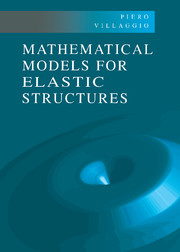Book contents
- Frontmatter
- Contents
- Preface
- Introduction
- Chapter I Basic Concepts
- Chapter II Rod Theories: Three-dimensional Approach
- Chapter III Rod Theories: Director Approach
- Chapter IV Theories of Cables
- Chapter V Theories of Membranes
- Chapter VI Theories of Plates
- Chapter VII Theories of Shells
- References
- Index of Authors Cited
- Index
Chapter II - Rod Theories: Three-dimensional Approach
Published online by Cambridge University Press: 11 September 2009
- Frontmatter
- Contents
- Preface
- Introduction
- Chapter I Basic Concepts
- Chapter II Rod Theories: Three-dimensional Approach
- Chapter III Rod Theories: Director Approach
- Chapter IV Theories of Cables
- Chapter V Theories of Membranes
- Chapter VI Theories of Plates
- Chapter VII Theories of Shells
- References
- Index of Authors Cited
- Index
Summary
Geometrical Properties of Rods
From the beginnings of human civilization, rods have been used in making rudimentary tools and weapons. In the theory of the elasticity, rods have been used to model a range of physical structures such as beams, columns, and shafts, the characteristics of which is slenderness that is of having a longitudinal dimension much greater than either of the transverse dimensions. The term “bar” is sometimes used synonymously with rod, although in general speech it need not imply that one dimension is very much greater than others. Occasionally, when modeling a physical object, it is possible to identify it immediately as a rod; for example, the mast of a boat. On other occasions a physical structure can be regarded as an assembly of rods; for example, certain buildings or bridges. Rods are important because they offer the simplest but nontrivial model to which the theory of elasticity can be applied and verified experimentally. The earliest theories of rods formulated at the beginning of the seventeenth century arose as a consequence of the research of Beeckman and Mersenne (Truesdell 1960, Prologue, Sec. 3.4), but the most significant progress made in the theory was due to James Bernoulli, Euler, Saint-Venant, Kirchhoff, and Michell. Implicit in using rod models is the facility of being able to work with a single independent variable representing the arc measured along a certain curve. In slender bodies this avoids the mathematical obstacles that arise from having the three independent variables of general continuum theory.
This then requires the construction of a rational scheme for approximating the system of field equations of general continua by a system containing one spatial independent variable and, ultimately, the time. However, in order to be acceptable, the approximation procedure must explain at each stage the relationship between the approximate solutions and those of the original three-dimensional problem; in addition, it must contain, at least in principle, the method of estimating the approximation error; finally, the approximate quantities must have a significant mechanical interpretation in the form of stress averages over certain sections of the body.
Information
- Type
- Chapter
- Information
- Mathematical Models for Elastic Structures , pp. 61 - 161Publisher: Cambridge University PressPrint publication year: 1997
